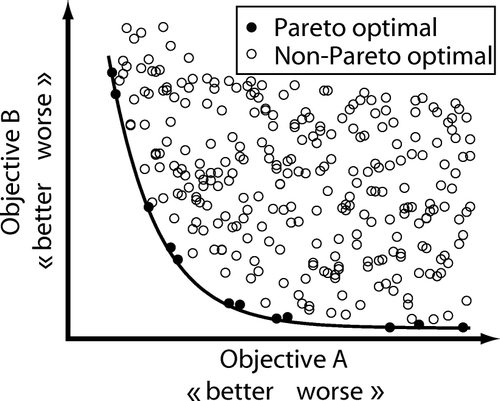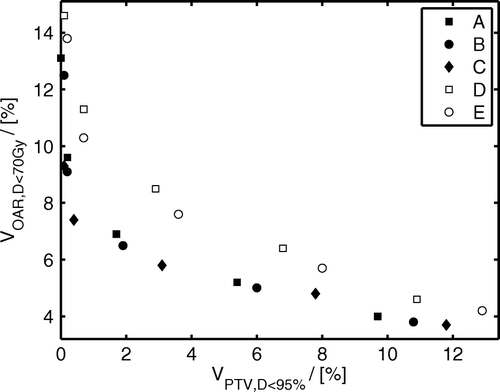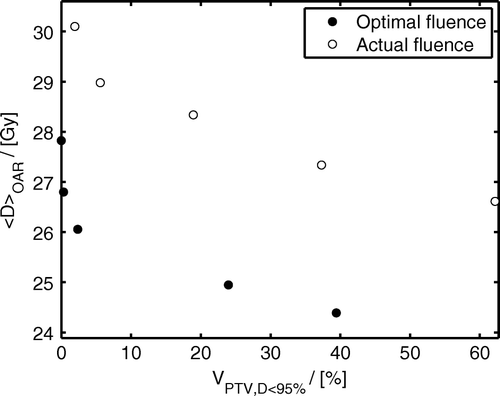Abstract
Pareto optimality is a concept that formalises the trade-off between a given set of mutually contradicting objectives. A solution is said to be Pareto optimal when it is not possible to improve one objective without deteriorating at least one of the other. A set of Pareto optimal solutions constitute the Pareto front. The Pareto concept applies well to the inverse planning process, which involves inherently contradictory objectives, high and uniform target dose on one hand, and sparing of surrounding tissue and nearby organs at risk (OAR) on the other. Due to the specific characteristics of a treatment planning system (TPS), treatment strategy or delivery technique, Pareto fronts for a given case are likely to differ. The aim of this study was to investigate the feasibility of using Pareto fronts as a comparative tool for TPSs, treatment strategies and delivery techniques.
In order to sample Pareto fronts, multiple treatment plans with varying target conformity and dose sparing of OAR were created for a number of prostate and head & neck IMRT cases. The DVHs of each plan were evaluated with respect to target coverage and dose to relevant OAR.
Pareto fronts were successfully created for all studied cases. The results did indeed follow the definition of the Pareto concept, i.e. dose sparing of the OAR could not be improved without target coverage being impaired or vice versa. Furthermore, various treatment techniques resulted in distinguished and well separated Pareto fronts.
Pareto fronts may be used to evaluate a number of parameters within radiotherapy. Examples are TPS optimization algorithms, the variation between accelerators or delivery techniques and the degradation of a plan during the treatment planning process. The issue of designing a model for unbiased comparison of parameters with such large inherent discrepancies, e.g. different TPSs, is problematic and should be carefully considered. fc
The Italian economist Vilfredo Pareto introduced the mathematical concept of Pareto optimality, a concept that formalises the trade-off between a given set of mutually contradicting objectives Citation[1], Citation[2]. For a given optimisation problem, an endless number of solutions may exist. Some, however, are mathematically more favourable than others. A solution is said to be Pareto optimal when it is not possible to improve one objective without deteriorating at least one of the other. A Pareto front is constituted by the Pareto optimal solutions (). The Pareto concept applies well to the inverse planning process, which involves inherently contradictory objectives, high and uniform target dose on one hand, and sparing of surrounding tissue and nearby OAR on the other.
Figure 1. A schematic sketch, illustrating the Pareto concept. For two mutually contradicting objectives, A and B, an endless number of solutions exist. The solutions where one of the objectives can not be improved without detoriating the other are Pareto optimal. All Pareto optimal solutions lie on the Pareto front (represented by the solid line) and are dominating the non-Pareto optimal solutions.

The basis for inverse treatment planning is the so called Dose Volume Objectives (DVOs), i.e. the prescribed dose to target structures and dose limitations for OAR. By assigning weight-factors to the DVOs, the intensity profiles are determined in a computerized iterative optimization process. The goal of the optimization is to achieve a dose distribution as similar to, or better than, the specified dose distribution as possible. The deviation is quantified through an objective function Citation[3]. The resulting compromise between the mutually contradicting objectives often leads to a clinically non acceptable result. Thus, it is often necessary to run several optimizations with different parameters in order to reach an acceptable compromise Citation[4]. Even though a plan has been approved for treatment there is no guarantee that it is the best plan since the number of possible combinations of parameters is virtually endless. A previous study by Thieke et al. has demonstrated the usefulness of creating a database of Pareto optimal solutions for interactive treatment plan selection on a case to case basis Citation[5]. A novel idea, introduced in this study, is to sample a number of Pareto fronts by varying a single parameter, for example beam energy, sets of gantry angles or delivery technique, while keeping all other parameters constant. Due to the specific characteristics of the varied parameter, the fronts are likely to differ from each other. Comparative treatment planning has hitherto often been rather inconclusive. For instance, when comparing different IMRT delivery techniques (e.g. step&shoot vs. sliding window); it may have been found that one of the techniques is capable of better target coverage, while the other is better at sparing risk organs. This is obviously not the whole picture but leaves room for a subjective interpretation of the weighting factors involved in the multi-criteria optimisation process. By sampling the entire Pareto front for a case, however, it may be possible to a make a much more just and comprehensive comparison of the two systems. In this paper we intend to show that this is a feasible approach by using a few examples and that only a few clinical plans and cases are needed for this purpose. A recent study by Craft and Bortfeld Citation[14] concludes that N + 1 plans (where N is the number of objectives) are sufficient to sample the Pareto front. Comparison of the sampled Pareto fronts, rather than individual treatment plans, may then be used as an evaluative tool for TPSs, treatment strategies (beam energy, gantry angles etc) or delivery techniques (IMRT, Intensity Modulated Arc Therapy, TomoTherapy etc) as a whole, where the most favourable Pareto front will represent the most advantageous of the techniques, strategies or TPSs investigated.
The aim of this study was to investigate the feasibility of using Pareto fronts as a comparative tool for TPSs, treatment strategies and delivery techniques.
Material and method
In this study Varian Eclipse 8.0 (Varian Medical Systems, Inc., Palo Alto, CA, USA) modelling a Varian 2300 IX (Varian Medical Systems, Inc., Palo Alto, CA, USA) was used for inverse planning. Two different types of cases were investigated; prostate and head & neck. All cases included were previously diagnosed and selected for IMRT treatment. Thus parameters such as contouring, beam energy, number of beams and gantry angles had already been set and could confidently be used as a basis for inverse planning. The prostate cases were planned using a five-field technique for a number of different gantry angle sets and beam energies (). The prescribed dose to the PTV was 78 Gy in 2 Gy fractions. Structures considered during the optimization process were the PTV and rectum. The head & neck cases were planned using a seven equidistant-field technique. The dose prescription was 68 Gy in 2 Gy fractions to the PTV. Structures considered during the optimization were the PTV, the ipsilateral parotid gland, the spinal cord and the medulla oblongata. Pareto fronts were created by adjusting the DVOs of an initial, clinical acceptable, plan, while keeping all other parameters constant.
Table I. Photon beam energies and gantry angle sets studied for the prostate cases.
Pareto fronts based on (i) optimal fluence as well as the deliverable fluence using dynamic IMRT, henceforth denoted as actual fluence, for a number of head & neck cases and on (ii) actual fluence for a number of prostate cases were produced. For the prostate cases various photon beam energies and gantry angle sets were investigated separately (). Initially a clinically acceptable plan was generated using an in-house site specific template as a basis. Additional plans were created by systematically varying the lower DVO for the PTV between 90 and 100% of the prescribed dose. Thus the target coverage was compromised whilst decreasing the rectal dose. The optimization process was limited to 150 iterations, but manually halted when no further improvement in objective function was achieved. In order to accomplish more clinically relevant results, the Normal Tissue Objective was utilized during the optimization. The Normal Tissue Objective is used for the part of the body which does not include the target. It considers the decrease in dose level as the distance from the target is increased, limits the dose level and prevents hot spots in healthy tissue. The conversion from optimal to segmented fluence is performed by the Leaf Motion Calculation (LMC) module, which incorporates the physical characteristics of the dynamic MLC device. The LMC determines the dynamic MLC leaf motion patterns and their corresponding segmented fluencies in an iterative calculation in which the segmented fluence is determined from the dynamic MLC sequence until maximum agreement between the segmented and optimal fluence is achieved. The actual fluence is obtained via a complete dose calculation based on the segmented fluence. The sliding window modality was used for the dynamic MLC segmentation and dose calculation was performed using the pencil beam dose calculation algorithm.
Data analysis
The selection of endpoints is a vital task; all endpoints chosen must be clinically relevant and clearly defined. For this feasibility study the endpoints were chosen based on clinically accepted recommendations and findings of previous studies Citation[6–11].
The endpoints of interest for this study were
the relative underdosed volume of the PTV, defined as the relative volume of the PTV receiving less than 95% of the prescribed dose,
the relative rectum volume exceeding 70 Gy for the prostate plans and
the ipsilateral parotid gland mean dose for the head and neck plans.
Results
Pareto fronts were successfully sampled for all cases ( and ). The results clearly demonstrate that the sampled Pareto fronts follow the definition of the Pareto concept, i.e. no solution simultaneously improving, or detoriating, both parameters was found ( and ).
Figure 2. Relative rectal volume exceeding 70 Gy plotted versus the relative volume of the PTV for five different settings (see ) generated by Varian Eclipse 8.0. The data points representing the Pareto front follows the definition of the Pareto concept i.e. one of the parameters can not be improved without the other one being detoriated. No significant differences are observed for sets of the same beam energy (A-C and D,E), while 15 MV (A-C) clearly is superior to 6 MV (D,E).

Figure 3. Parotid gland mean dose plotted versus underdosed volume of PTV for a head and neck cases, based on optimal and actual fluence generated by Varian Eclipse 8.0. The data points representing the Pareto front follows the definition of the Pareto concept i.e. one of the parameters can not be improved without the other one being detoriated. The results clearly show that the quality of a plan will be reduced when proceeding from optimal to actual fluence.

The usage of Pareto fronts as an evaluative tool is shown when two Pareto fronts of a case are compared. The results of the prostate cases show that 15 MV is superior to 6 MV, but that no significant differences can be observed for intra beam energy gantry angle sets () for the studied cases. The head and neck case showed a significant reduction of plan quality when proceeding from optimal fluence to actual fluence ().
Discussion
The aim of this feasibility study was not to conclude which set of gantry angle sets or which beam energy that is most favourable for a specific prostate case or to calculate the exact plan degradation when proceeding from optimal to actual fluence for a head and neck case, but to show that it is possible to use Pareto fronts as an evaluative tool for treatment strategies or delivery techniques as a whole.
The examples chosen are just examples; many questions of interest can be resolved using Pareto front evaluation provided that representative and clinically relevant endpoints can be formulated. The gantry angle sets and beam energy for IMRT prostate treatment were of particular interest since no convention exists even though the issues have been investigated in previous studies Citation[12], Citation[13]. The results of this feasibility study clearly demonstrate that it is feasible to use Pareto fronts as an evaluative and comparative tool for TPSs and treatment strategies. Although further investigations are needed prior to adopting the concept clinically, the advantages of using Pareto fronts as an evaluative tool are clear; Pareto front evaluation would be a very useful tool for clinics in the process of acquiring a new TPS or delivery technique or when deciding which treatment strategy or delivery technique to employ on a case to case basis.
In order to obtain clinically relevant Pareto fronts the endpoints must be chosen wisely. The issue of choosing proper endpoints needs to be thoroughly investigated. An additional issue regarding designing impartial comparisons for systems of large inherit discrepancies, e.g. different TPSs and delivery techniques, needs to be resolved prior to making such comparisons. Pareto fronts have been successfully created using a secondary TPS, Oncentra MasterPlan v1.5 (Nucletron B.V., Veenendaal, The Netherlands). As fair comparisons could not be made at this stage, the Oncentra MasterPlan results have been omitted. Theoretically, the Pareto front evaluation concept applies equally well to all inverse planning based delivery techniques. Our vision for this concept is to be able to design impartial and clinically relevant comparisons between TPSs and for all existing delivery techniques, including IMRT, TomoTherapy, and Intensity Modulated Arc Therapy etc. A TPS producing numerous Pareto optimal solutions for IMRT has been developed by Thieke et al. Citation[5]. A TPS capable of producing multiple Pareto optimal solutions for a variety of treatment strategies and delivery techniques would be a very powerful tool in the treatment planning process.
In this feasibility study a single PTV and OAR were comprised. Clinically, the optimization process takes multiple target structures and numerous organs at risk into account. Thus Pareto surfaces, rather than Pareto fronts needs to be studied. The study is also limited in the number of treatment plans produced (four per case). Further probing of the solution space might prove that better solutions exist i.e. that the solutions found are just locally Pareto optimal or even non-Pareto optimal. The aim of this study was to sample two-dimensional Pareto fronts and to investigate the feasibility of using the Pareto fronts as a comparative tool for TPSs, treatment strategies and delivery techniques. For this purpose, the number of plans produced was sufficient in order to sample the Pareto Citation[14]. In order to effectively use Pareto fronts as an evaluative tool an algorithm producing a vast number of Pareto front optimal solutions, by systematically varying all parameters of interest, needs to be developed.
Acknowledgements
Declaration of interest: The authors report no conflicts of interest. The authors alone are responsible for the content and writing of the paper.
References
- Pareto V. Cours d'Economie Politique Vol. II F. F. Pichou, Paris (France) 1897
- Juran JM. Quality control handbook3rd ed. McGraw-Hill, New York (NY) 1974
- Webb S. The physical basis of IMRT and inverse planning. Br J Radiol 2003; 76: 678–89
- Hunt MA, Hsiung CY, Spirou SV, et al. Evaluation of concave dose distributins created using an inverse planning system. J Radiat Oncol Biol Phys 2002; 54: 953–62
- Thieke C, Küfer K-H, Monz M, Scherrer A, Alonso F, Oelfke U, et al. A new concept for interactive radiotherapy planning with multicriteria optimization: First clinical evaluation. Radiother Oncol 2007; 85: 292–8
- International Commission on Radiation Units and Measurements. Prescribing, recording and reporting photon beam therapy (supplement ti ICRU report 50). ICRU report 62. Bethseda, MD: ICRU; 1999
- Eisbruch A, Ten Haken RK, Kim HM, Marsh LH, Ship JA. Dose, volume and function relationships in parotid salivary glands following conformal and intensitymodulated irradiation of head and neck cancer. J Radiat Oncol Biol Phys 1999; 45: 577–87
- Eisbruch A, Ship JA, Dawson LA, Kim HM, Bradford CR, Terrell JE, et al. Salivary gland sparing and improved target irradiation by conformal and intensity modulated irradiation of head and neck cancer. World J Surg 2003; 27: 832–7
- Huang EH, Pollack A, Levy L, Starkchall G, Dong L, Rosen I, et al. Late rectal toxicity: Dose-volume effects of conformal radiotherapy for prostate cancer. J Radiat Oncol Biol Phys 2002; 54: 1314–21
- Boersma LJ, van den Brink M, Bruce AM, Shouman T, Gras L, te Velde A, et al. Estimation of the incidence of late bladder and rectum complications after high-dose (70–78 Gy) conformal radiotherapy for prostate cancer, using dose-volume histograms. Int J Radiat Oncol Biol Phys 1998; 41: 83–92
- Storey MR, Pollack A, Zagars G, Smith L, Antolak J, Rosen I. Complications from radiotherapy dose escalation in prostate cancer: Preliminary results of a randomized trial. Int J Radiat Oncol Biol Phys 2000; 48: 635–42
- Pugachev A, Li JG, Boyer AL, Hancock SL, Le Q-T, Donaldson SS, et al. Role of beam orientation optimization in intensity-modulated radiation therapy. Int J Radiat Oncol Biol Phys 2001; 50: 551–60
- Pirzkall A, Carol MP, Picket B, Xia P, Roach III M, Verhey LJ. The effect of beam energy and number of fields on photon-based IMRT for deep-seated targets. J Radiat Oncol Biol Phys 2002; 53: 434–42
- Craft D, Bortfeld T. How many plans are needed in an IMRT multi objective plan database?. Phys Med Biol 2008; 58: 2785–96